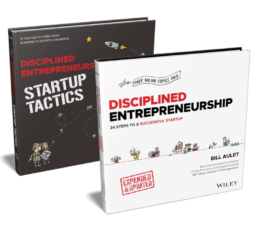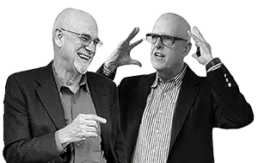Sign up for our newsletter
The books
This methodology with 24 steps and 15 tactics was created at MIT to help you translate your technology or idea into innovative new products. The books were designed for first-time and repeat entrepreneurs so that they can build great ventures.

(Part 2 of 3: Opportunity recognition/assessment, resource leveraging/value creation, and building support networks)
“Everything that can be invented has been invented.”
“In my opinion, all previous advances in the various lines of invention will appear totally insignificant when compared with those which the present century will witness.”
“The advancement of the arts, from year to year, taxes our credulity and seems to presage the arrival of that period when human improvement must end.”
The idea that the head of the country’s patent office predicted the end of invention is laughably ironic until replaced by the irony that it was the opposite of how Commissioner Duell actually felt. How then more absurd is the actual prognostication 56 years earlier, also by the head of the country’s patent office. Want some more irony? Samuel F.B. Morse would invent no less than the telegraph in 1844, a year later.
Fortunately for civilization, entrepreneurs are more the Duell types. There is little to nothing that can’t be improved, the entrepreneur must believe. In his piece on Antifragility and the Entrepreneur, Bill Aulet describes entrepreneurship as “an operating model that people can apply… where they are utilizing resources that are not under their control.” Entrepreneurs are eager to plunge into the unknown; antifragile entrepreneurs are the ones who learn and improve from all the travails that the unknown provides.
Process Skills
Even if your entrepreneurial goal is more for your future than the future, dealing with all of the unknowns demands an array of antifragile “process” skills: recognizing opportunities; leveraging resources to develop new products or services (more on this skill in the next article on creative problem solving); conveying your vision, and developing and using a network to get it done.
Again, the microcosm of this process is the sketch that the improv troupe performs. They recognize opportunities in the suggestions from the audience; they mime their resources and rely on the resources of their cohorts to create a scene; they present their idea through a variety of movements, sound effects, and speech; and they move and change and adapt the scene as it progresses in order to convey a “story” and get to a satisfactory conclusion. In addition to the skills we discussed in the previous article—listening, flexibility, embracing surprise, and self-confidence—they rely on teamwork, not fearing failure, using all available objects and resources (which usually means their clothes and body parts, and, if they are lucky, chairs or a hula hoop), and creating the other places, people and objects that they may need.
Teamwork
 Just as listening is universal to virtually all improv exercises, so is teamwork. Even before you build your idea into an organization, you will need to understand that entrepreneurship does not mean going it alone. You may have left a boss behind, but you will need to gather a team of individuals you respect whose skills complement your own. And, you will need to work with them.
Just as listening is universal to virtually all improv exercises, so is teamwork. Even before you build your idea into an organization, you will need to understand that entrepreneurship does not mean going it alone. You may have left a boss behind, but you will need to gather a team of individuals you respect whose skills complement your own. And, you will need to work with them.
Though most improv exercises and games are group efforts, there are some that focus on teamwork. A favorite of our students at Serious Improv! is “Remote Control,” a two-person exercise. The controller makes all kinds of random sounds, animal noises, gibberish, what-have-you; the controlee responds physically, matching various movements to the sounds. Then they switch by having the movement person “control” the sound person.
Exercises can also have a group of improvisers, often in a circle, learning to collaborate. They can build a story one word at a time, or, in typical “Yes… And” fashion, keep adding on to a “Rumor,” one sentence at a time. “Machine” allows the participants to actually feel what it is like to teamwork. In a circle or a line, any number of willing improvisers can together create a machine. One person starts with a simple—preferably mechanical—motion, such as lifting her arm up and down in a chopping motion. The second person must create a motion that works with the first motion. So, he may move his arm from side to side so that it crosses the plane of the chopping motion but then moves out of the way before the arm comes down. Each person does a different motion until everyone is working together. Once they are going strong, they can each add a sound effect. Then, to make things fun (aka surprising), they must reverse the machine. When they have the hang of this, they can start all over with a more objective-driven vending machine or assembly-line machine, one that makes candy or booze or televisions, or…. The beauty of “Machine” is that each person is clearly “working” both as an individual and as part of a whole.
Leveraging Hidden Talents
 One of the greatest and most antifragile entrepreneurs of all time, St. Paul, or Saul of Tarsus, revealed one of the secrets to his organizational abilities in his letter to the Corinthians. He discusses the need for a variety of skills, or spiritual gifts as they have come to be known, and makes it clear that all gifts are of equal importance. (Only recently have psychologists and educators come around to understanding that there are, likewise, many bits of intelligence and many ways to learn.) The lesson here for tomorrow’s entrepreneur is to seek out and truly appreciate the skills, gifts, and interests that make us different.
One of the greatest and most antifragile entrepreneurs of all time, St. Paul, or Saul of Tarsus, revealed one of the secrets to his organizational abilities in his letter to the Corinthians. He discusses the need for a variety of skills, or spiritual gifts as they have come to be known, and makes it clear that all gifts are of equal importance. (Only recently have psychologists and educators come around to understanding that there are, likewise, many bits of intelligence and many ways to learn.) The lesson here for tomorrow’s entrepreneur is to seek out and truly appreciate the skills, gifts, and interests that make us different.
One of the many nice things about being human is that we often have resources, skills and hidden talents that just the right entrepreneurial leader can discover and utilize in somewhat the same way she might utilize other non-human resources. Rather than just have participants “tell” each other what they like to do, one improv exercise, “Rapport,” has two people act out five things they like to do, without speaking. They must also find two things they have in common. (They can also draw their five favorite things, again, without speaking.)
Understanding the likes and dislikes of your fellow workers or your client – what incentivizes them—is also key to the entrepreneurial skill of conveying a compelling vision. Even more important than the presentation skills and being used to being on stage that improv gives you, is knowing who you are talking to. Advertising copywriters often make excellent writers because they are used to visualizing their audience. It is usually handed to them in the marketing strategy: do-it-yourselfers, 25 to 80 years old, men and women in small towns, which means you address your message to Uncle Ed and Aunt Cindy in Springton, Colorado. When convincing others of your vision, do you stress profits or saving the world or job creation or….? If you know your audience, you know the answer.
Leveraging Resources
 Leveraging non-human resources involves the ability to access and use the tools at hand in the same way you would discover and utilize human resources. Object exercises are fundamental to improv and effective in teaching this entrepreneurial skill. The cliché one is more an exercise in creativity; it involves thinking up as many uses for, say, a brick as possible. Similarly, participants around a circle can take a simple object and pass it around, each one inventing a new use for that object.
Leveraging non-human resources involves the ability to access and use the tools at hand in the same way you would discover and utilize human resources. Object exercises are fundamental to improv and effective in teaching this entrepreneurial skill. The cliché one is more an exercise in creativity; it involves thinking up as many uses for, say, a brick as possible. Similarly, participants around a circle can take a simple object and pass it around, each one inventing a new use for that object.
One group, we had at Serious Improv! took it upon themselves to accept one person’s suggestion and “Yes… And” it, turning a trashcan lid into a campfire and the whole circle into campers building and stoking the fire and then warming themselves and even chatting about the next day’s hike. So, now, after each person in the circle has had a turn coming up with a new use for the object, we have a second part in which the participants can randomly say something that shows their acceptance of another person’s suggestion. They can then “Yes… And” the previous person’s statement or make a statement that shows they are accepting yet another person’s suggestion. So, an object can be a knife in a cooking school for a bit and then be a laser pointer at a boring lecture. And on and on….
Akin to resource leveraging is recognizing opportunities and creating value/developing products or services, which we will discuss in the article on creative problem-solving. However, there is one improv/roleplay exercise that encompasses all of these skills as well as that of conveying a compelling vision—“Commercial.” Two improvisers take a suggestion for either an imaginary or real product, and maybe a name for the product. One person acts as the expert and demonstrates the product and its various attributes and selling points, but speaks in gibberish (or doesn’t speak at all, or maybe just makes sound effects). The other person interprets the actions, gibberish and sound effects into English commercial-type hype. A little wrinkle to this exercise, and one that makes it a particularly good antifragile one, is if, at the command of someone in the audience, the product doesn’t perform as it should. Then, the two improvisers must demonstrate its failure, and then come up with something that the product actually does quite well. So, what starts off like a high-powered juicer for everything but fruits, goes haywire, and ends up being an organic paint gun or candy maker or a machine to throw tomatoes back at the audience. Or….
Control
 Most of the skills we have discussed so far are about “utilizing resources.” But what about the part where the resources are “not under [your] control,” speaking of mega-juicers that go haywire?
Most of the skills we have discussed so far are about “utilizing resources.” But what about the part where the resources are “not under [your] control,” speaking of mega-juicers that go haywire?
As we discussed in the last piece, control is like planning, subject to the constant element of surprise and therefore tenuous at best. Antifragility demands you keep your desire for control in check, balancing it with your ability to improvise when things are out of control. If you have children, you will know exactly what that means (though, with them, you are entitled to not necessarily embrace every surprise). As you can see, there is no “control” in Bill Aulet’s description of the antifragile entrepreneur: “grow when exposed to volatility, randomness, disorder, and stressors, and love adventure, risk, and uncertainty.”
If you have ever ridden a horse, you may understand where control meets adventure and uncertainty. Never mind leading it to water and making it drink. Once you are heading back to the stables, the horse knows it and picks up its gait because the sooner it arrives the sooner it gets rid of you and gets food, water, and good brushing. But… but… you have the reins! You are supposed to be in control. You may not want to return so quickly. You may want to check out a particularly interesting side path. What is the cost to you for stubbornly countering the horse’s well-trod incentives?
All too often with bosses who lack true leadership, it is an ego thing. They mistakenly suppose that any kind of concession of control is weakness or will be perceived as weakness. Their original objective may not even be a factor. If you get yourself in this dilemma, there is no good choice. You should have seen it coming. The horse and your fellow riders will know if you have to pull hard on the reins, that you are a tenderfoot. As a parent, it is the same if you have ever had to utter those words, a la Napoleon at his Waterloo: “Because I said so. That’s why!” You lose, and not just control.
We can’t say it enough. The antidote to the loss of control is to embrace surprise, and that is what improv can teach you. That, and to not fear failure. Improv also develops those skills by honing your spontaneity. The exercise “Buzzer” is a fun three-person way to do that. Two people have a simple conversation, let’s say about their plans for summer. The third person is the buzzer; every time she buzzes, whoever said the last line must “take it back,” changing it to something else. So, if an improviser is buzzed while saying, “I look forward to my trip to Hawaii,” he might say, after being buzzed, “I am dreading my trip to Hawaii,” or, “I am dreading my trip to the Antarctic,” or whatever. A good buzzer will truly put the improviser to the test.
There is one more little aid to those antifragile entrepreneurs who are willing to risk volatility every day. It is a mantra: “So What If….” It is a way of dealing with what you may suppose is a worst-case scenario. However, when you say it out loud, starting with, “So, what if…,” as in, “So what if I don’t get this contract and I waste two months in courting the client…?” You may realize that the worst-case is bad but not nearly as bad your imagination, or your lizard brain whispered to you in the dead of night.
To teach this mantra, we have students do a rather simple exercise, “Fortunately/Unfortunately,” which is like “Yes… And,” but every other turn is negative. The first person starts out with, “Fortunately, I bought the last television that was on sale.” The next person says, “Yes, but unfortunately, you weren’t able to get a warranty for it.” The first person can then respond with something positive, such as “Yes, but I know of third-party warranties online.” Or, to up the ante, the exercise can substitute “So, what if…” for the second person. Then, the first person may say some kind of plan, “I’m going to ask Barbara to marry me tomorrow.” The second person says, “So what if she says no.” The first person then says, “I will get a refund on the ring.”
So, next time you plunge into the deep dark recesses of all that is not under your control, just keep in mind, “So, what if….” Even if it is not the light at the end of the tunnel, or even the canary in the coal mine, it will keep you antifragile.
Read all three parts of the article:
- Part 1: Perseverance and resilience, self-confidence, and risk management.
- Part 2: Opportunity recognition and assessment, resource leveraging, value creation and building networks (current article)
- Part 3: Creative problem-solving and guerilla skills.
The authors
Mike Grimshaw & Nate Lee
Mike and Nate's backgrounds cover an impressive array of domains, from founding startups and angel investing, to sales, leadership & management training, advertising, financial strategy, customer engagement, and more. Together, they founded Serious Improv, where they use improv to help businesses and organizations improve the way they work .

The Disciplined Entrepreneurship Toolbox
Stay ahead by using the 24 steps together with your team, mentors, and investors.
How relevant was this article to you?
Click on a star to rate it!
Average rating 5 / 5. Vote count: 4
No votes so far! Be the first to rate this post.
We are sorry that this article was not useful for you!
Let us improve this post!
Tell us how we can improve this post?
